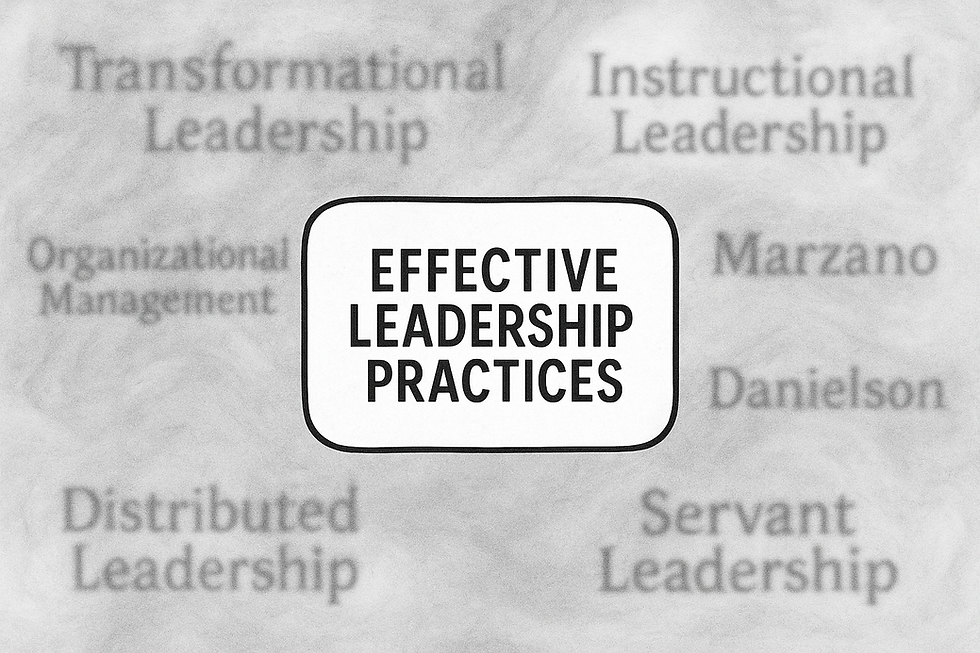From Framework Overload to Focused Leadership
- Chad Ransom
- Aug 18, 2025
- 3 min read
"Almost all successful leaders draw on the same repertoire of basic leadership practices." — Leithwood, Harris, & Hopkins (2019)
When it comes to leadership practices, many school leaders feel trapped in a maze of choices.
Should I be an instructional leader or a transformational leader?
Should I follow Marzano’s framework or Danielson’s?
Should I be a servant leader, distribute leadership, or focus on organizational management?
Research exists to support all of these approaches, and the result is often confusion, second-guessing, and stalled action. In reality, these are false choices. Decades of research show that the most effective leaders—no matter their “style” or preferred model—tend to do the same core things. These shared practices show up across every framework worth its salt. The real challenge is not picking a label—it’s doing the right work well.

The real magic in leadership happens when clarity meets action. You already know the big goals: improved instruction, stronger relationships, higher trust, and engaged families. But knowing what to aim for is only the first step. The next challenge—one that separates the good from the great—is choosing the right leadership practices and doing them so well they actually move those levers.
Personal Experience:
When I work with principals who feel “stuck,” it’s rarely because they don’t know the right practices. It’s usually because those practices are too broad or abstract or overwhelming in their current form. Once we unpack them—turning “build trust” into clear, observable actions—leaders suddenly see how to lead tomorrow in a way that moves results next month.
A Shared Playbook for Success
Leithwood, Harris, & Hopkins (2019) make it clear: almost all successful leaders draw on the same repertoire of basic leadership practices. These practices transcend leadership models, showing up in research on instructional leadership, transformational leadership, distributed leadership, and beyond. Here’s what they look like in action:
Setting Direction and Goals
Looks Like: Using baseline data to co-create 2–3 measurable improvement goals with staff, then revisiting them in every leadership meeting to track progress.
Example: A principal leading a math improvement effort posts progress charts in the staff lounge, updating them monthly so teachers see tangible movement toward the goal.
Building Relationships and Develop People
Looks Like: Scheduling weekly “walk-and-talk” times with different staff members, not to evaluate, but to listen and understand their perspective.
Example: During a hallway conversation, a leader remembers a teacher’s concern from weeks ago and follows up—showing they truly listened and cared.
Looks Like: Pairing new teachers with skilled mentors, observing together, and providing actionable feedback tied to instructional goals.
Example: An instructional coach and principal meet with each teacher quarterly to set one targeted professional learning goal, then follow up within two weeks.
Develop the Organization to Support Desired Practices
Looks Like: Ensuring hiring, budgeting, scheduling, and PD all point toward the same improvement priorities.
Example: When improving literacy is the goal, the leader directs discretionary funds toward classroom libraries and PD on reading strategies.
Looks Like: Removing barriers—like outdated pacing guides or lack of planning time—that prevent teachers from implementing best practices.
Example: A leader rearranges schedules so grade-level teams have a shared planning period twice a week for collaborative lesson design.
Improve the Instructional Program:
Looks Like: Leading short data reviews every two weeks focused on formative assessments, then planning rapid-response instructional changes.
Example: After reviewing student writing samples, a leader organizes a peer observation cycle so teachers can see effective modeling in action.
Leaders don’t need to choose between models or get stuck in an endless search for the “perfect” framework. The research is clear—across contexts, across styles, and across decades—effective leaders consistently enact these core practices. The difference is in the execution: doing the right work, in the right way, with relentless focus.
Even the best leaders can’t do it all alone. In our next post, we’ll explore why every effective leader shares leadership with others—and how to build structures so teachers, coaches, and staff can lead alongside you.
Discussion Question
Which of these seven practices is most fully alive in your school—and what’s one step you could take this month to strengthen it?




Comments